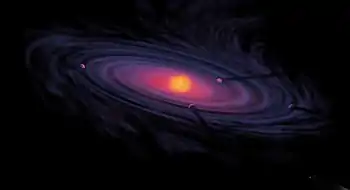
The formation and evolution of the Solar System began 4.6 billion years ago with the gravitational collapse of a small part of a giant molecular cloud. Most of the collapsing mass collected in the centre, forming the Sun, while the rest flattened into a protoplanetary disc out of which the planets, moons, asteroids, and other small Solar System bodies formed. This widely accepted model, known as the nebular hypothesis, was first developed in the 18th century by Emanuel Swedenborg, Immanuel Kant, and Pierre-Simon Laplace. Beginning with the initial formation, the Solar System has evolved considerably. Many moons formed from circling discs of gas and dust around their parent planets, while many other moons are believed to have been captured or (in the case of the Earth's Moon) to have resulted from a giant collision. Collisions between bodies have occurred continuously up to the present day and are central to the evolution of the system. The planets' positions often shifted outward or inward, and planets have switched places. This planetary migration is now believed to be responsible for much of the Solar System's early evolution. Just as the Sun and planets were born, they will eventually die. In roughly 5 billion years, the Sun will cool and bloat outward to many times its current diameter (becoming a red giant) before casting off its outer layers as a planetary nebula and leaving behind a stellar corpse known as a white dwarf. (Full article...)